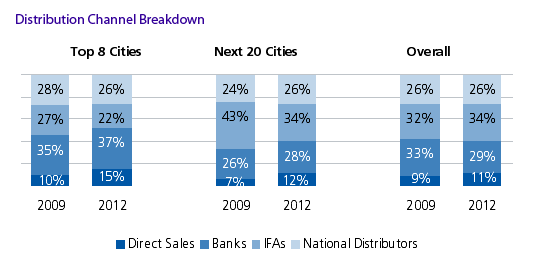The Evolution of the Indian Mutual Funds Landscape: Regulation and Technology
Abstract
Regulatory changes in the Indian mutual fund industry are reshaping the market. The removal of the entry load, parity across fund schemes, and restrictions in launching schemes mean the landscape has radically changed for stakeholders.
In a new report, The Evolution of the Indian Mutual Funds Landscape: Regulation and Technology, Celent analyses the impact of regulatory changes on industry players, with a focus on two aspects of the mutual fund business: regulation and technology.
The removal of entry load has an adverse impact on the distribution and sales of funds in the retail segment. Many distributors are expected to abandon selling mutual funds and focus on distributing insurance products or other fixed deposit products. To keep the distributors in business, fund houses will have to offer compensation from their own pockets. This increased expense, lack of organized distribution channels, and decline in profitability may force some smaller players to quit the business and could result in industry consolidation.
As a result, direct sales will make significant headway, mostly in the urban areas. Although direct sales only account for 10% of mutual funds sold in the top eight cities, they are likely to grow significantly by 2012. Independent financial advisers (IFAs) in semiurban areas will be affected the most by this change in regulation.
The role of distributors is likely to evolve. Now that the upfront commission will be determined, to a great extent, by the investor through negotiation with the distributor, investors will pay according to the level of service from the distributor. Therefore, distributors must focus on providing value-added and customized advisory services to cater to individual needs as well as the risk appetite of each investor. This not only pertains to advisory service for selling of mutual funds, but can be enhanced if distributors take an umbrella approach of maintaining a number of financial products under their portfolios.
“A major issue in Indian regulation is that financial products are regulated by various agencies. The insurance segment is monitored by IRDA, while the capital markets are controlled by SEBI,” says Arin Ray, an analyst at Celent and coauthor of the report. “While entry loads for mutual funds have been removed, they persist for the insurance firms; this results in an asymmetrical compensation structure for distributors of two products, hindering growth of mutual funds.”
“A single super-regulator monitoring all the products is an idea which is being thought about, but there is a lot of opposition from many quarters,” adds Sreekrishna Sankar, an analyst at Celent and coauthor of the report.
This report analyses the impact of the recent changes in regulation from the perspective of asset managers, distributors, and investors. It discusses how the industry will evolve in the future as a result of these changes. The report also discusses further changes in regulation currently under consideration and their potential impact on the industry. It addresses the future of the distribution channel landscape, with a focus on the use of technology and online distribution. Finally, the report profiles two technology solution providers in this space.

